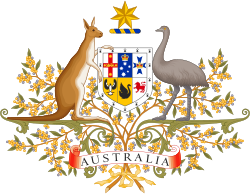Commonwealth v Yarmirr facts for kids
Quick facts for kids Commonwealth v Yarmirr |
|
|---|---|
 |
|
| Court | High Court of Australia |
| Full case name | Commonwealth of Australia v Yarmirr |
| Decided | 11 October 2001 |
| Case history | |
| Prior action(s) | |
| Court membership | |
| Judge(s) sitting | Gleeson CJ, Gaudron, McHugh, Gummow, Kirby, Hayne and Callinan JJ |
Yarmirr v Northern Territory was an important Australian court case decided in 2001. It was about whether Aboriginal people could have native title rights over areas of the sea, the sea-bed (the ocean floor), and the land beneath the sea. This case focused on an area near Croker Island in the Northern Territory. The final decision was made by Australia's highest court, the High Court of Australia.
Asking the Court for Native Title
This case started when Mary Yarmirr and other people from different clan groups asked the court to recognise their native title rights. They wanted these rights for the seas and sea-beds around Croker Island. They hoped to have exclusive possession, which means having the sole right to use and control the area.
The court decided that traditional owners do have native title rights to the sea and sea-bed. However, these rights are not exclusive. This is because of older common law rights that allow everyone to fish and travel freely in the sea.
The case aimed to answer some big questions under the Native Title Act 1993:
- Does common law apply to the sea beyond the low-water mark (where the tide is lowest)?
- Does common law recognise native title in these sea areas?
- How do other laws, like the Native Title Act, affect this recognition?
- What rights does the the Crown (the government) have over these waters?
- What rights does the Northern Territory government have over its coastal waters?
The Court's Decision
The first judge, Justice Olney, made a decision about the case. He said that the people from the Croker Island community have non-exclusive native title rights. This means they can use the sea and sea-bed in certain ways, but they don't have total control over it.
Their rights included:
- To travel through the area.
- To fish, hunt, and gather food for their personal, family, or community needs. This also included doing things for their traditional, cultural, and spiritual customs.
- To visit and protect places that are important for their culture and spirituality.
- To keep their cultural and spiritual knowledge safe.
The area they claimed was shown on maps. It included the seas, and any land or reefs within those boundaries. Croker Island itself and other islands in the area already had native title granted in 1980, so they were not part of this new claim.
Appealing the Decision
Both the Australian government (the Commonwealth) and the Aboriginal claimants were not fully happy with the first decision, so they both appealed. An appeal means asking a higher court to review the decision.
The case went to the Federal Court. Most of the judges there agreed with the first decision and dismissed both appeals.
After this, both the Commonwealth and the claimants appealed again, this time to the High Court of Australia. The High Court agreed with the Commonwealth's appeal and dismissed the claimants' appeal. This meant the native title rights were limited to the waters close to the land, including the areas where the tide goes in and out, both on the mainland and around the islands.
The claimants were also ordered to pay the costs for both their own appeal and the Commonwealth's appeal.
See also

